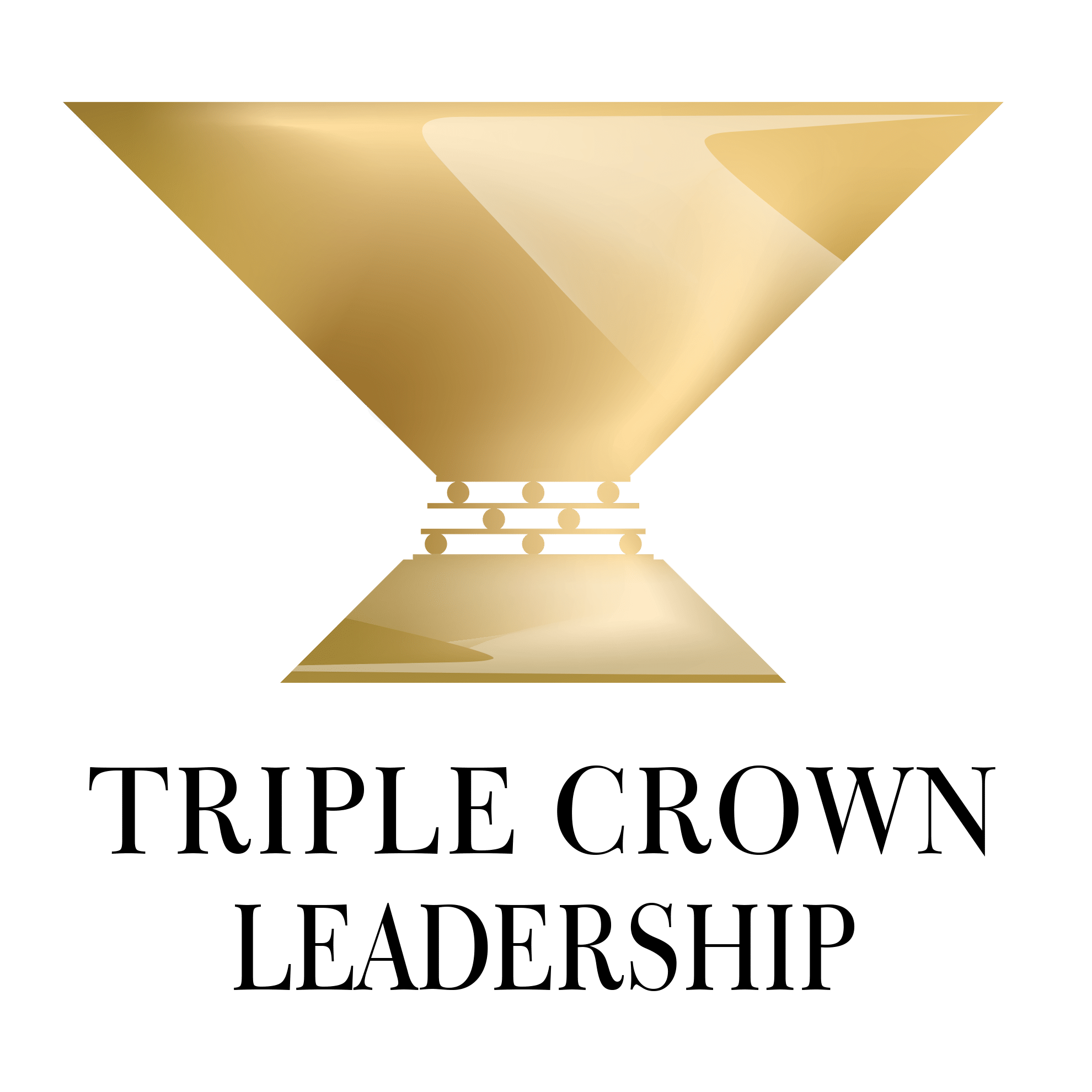
Through many years of research and experience, we discovered many practices employed by good leaders. Some practices were well known. Others were surprises. We’ve compiled an alphabetical guide of these good leadership practices. (Note: Underlined words have a link to a relevant article on that topic.)
We hope you gain some helpful tips from this guide. The world needs your leadership!
–Gregg and Bob Vanourek, co-authors, Triple Crown Leadership: Building Excellent, Ethical, and Enduring Organizations (a winner of the International Book Awards)
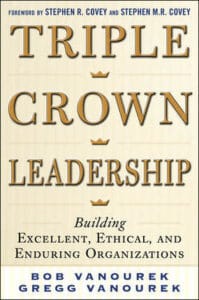
A:
- Accountable: Good leaders hold themselves and others accountable.
- Aim: A good leader’s overarching aim is to build an organization that is excellent, ethical, and enduring. (See also Chapter 1 of our book, Triple Crown Leadership.)
- Alignment: Good leaders align their followers collaboratively. (Our alignment framework is a ten-step process that coalesces people in an organization so they can achieve peak performance. See also Chapter 6 of our book, Triple Crown Leadership.)
- And: Good leaders build on what others have said by using “and” much more often than “but.”
- Art: Good leaders know that leadership is an art much more so than a set of things to do.
- Audacious: Good leaders set audacious goals when appropriate and pursue them with abandon.
- Authentic: Good leaders are authentic.
- Authority: Good leaders may or may not have the authority to lead but do so anyway. They most often persuade others rather than exercise their authority.
B:
- Backs: Good leaders have their people’s backs.
- Balance: Good leaders balance their professional and personal lives and help their followers do so as well.
- Believe: Good leaders believe in the inherent capabilities of people–and show it often.
- Belonging: Good leaders create a sense of belonging in their organization, in which people feel part of something, appreciated, and valued.
- Below: Good leaders sometimes lead from below in the organization even though they don’t have the authority to do so.
- Bite: Good leaders sometimes bite their tongues, letting others speak up and lead.
- Blame: Good leaders take responsibility and don’t blame others.
- Body Language: Good leaders learn how to read body language and tone of voice effectively.
- Born: Good leaders are made, not born, since most leadership practices are learned skills.
- Breakdown: Good leaders pay attention to the early warning signs of potential breakdowns and work proactively to avoid them. (See also Chapter 7 of our book, Triple Crown Leadership.)
- Bridge: Good leaders bridge factions by creating an atmosphere of shared purpose, mutual respect, and smart trust.
- Burnout: Good leaders avoid burnout for themselves and their colleagues.
- But: Good leaders use “and” much more than “but.”
C:
- Care: Good leaders sincerely care for people and show it consistently.
- Casualties: Good leaders refuse to tolerate toxic behavior even from star performers, and they turn jerks, know-it-alls, and bad apples into casualties, removing them from the organization when necessary.
- Celebrate: Good leaders celebrate people and their efforts regularly.
- Change: Good leaders embrace change to help people get to a better place.
- Change Management: Good leaders are change managers, taking a systematic approach to dealing with the changes to an organization’s goals, processes, or technologies.
- Character: Good leaders have healthy character and demonstrate it over and over again, thereby earning trust, respect, and goodwill.
- Choice: Good leaders choose to lead, even without a title or position of authority.
- Coach: Good leaders coach others by creating a safe space for reflection and dialogue, asking thought-provoking questions, raising people’s sights, unlocking potential, and holding people accountable for their commitments.
- Collaborative: Good leaders are collaborative, engaging with and connecting with their colleagues, offering suggestions, asking clarifying questions, and encouraging the collective work.
- Colors: Good leaders help define an organization’s “colors” (the shared purpose, values, and vision of an organization) and bring them to life in everyone’s work. (See also Chapter 3 of our book, Triple Crown Leadership.)
- Comfort Zone: Good leaders step out of their comfort zones—and help others do the same.
- Command-and-Control: Good leaders do not practice command-and-control order-giving to their direct reports.
- Communication: Good leaders are excellent communicators.
- Compassion: Good leaders are compassionate.
- Compliments: Good leaders know that compliments are important; they’re good at giving and receiving compliments and creating cultures where people compliment each other sincerely and frequently.
- Conflict Management: Good leaders manage conflicts constructively.
- Connect: Good leaders connect people.
- Control: Good leaders know that control is an illusion.
- Courage: Good leaders overcome fears and demonstrate courage.
- Creativity: Good leaders develop their ability to bring something new into existence through imaginative skill and foster that ability in their organization.
- Credibility: Good leaders recognize that credibility is the foundation of leadership, and that people must be able to believe in their leaders.
- Credit: Good leaders give credit much more than they take it.
- Crisis: Good leaders rise to the challenge of leading in crisis via radical focus, communicating both reality and confidence, establishing psychological stability, choosing and managing a crisis response team, and more. (See also Chapter 8 of our book, Triple Crown Leadership.)
- Culture: Good leaders create a healthy organizational culture.
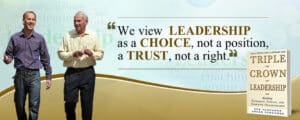
D:
- Decisions: Good leaders develop excellent decision-making processes—including listening to robust input from others—that help them make decisions that are ethical, thoughtful, and wise.
- Derailers: Good leaders develop their self-awareness through reflection and solicitation of feedback to know what inhibits their leadership effectiveness. (Take our Leadership Derailers Assessment.)
- Develop: Good leaders develop people intentionally, systematically, and generously.
- Dialogue: Good leaders practice respectful dialogue that elicits collective wisdom and understanding through openness and deep listening.
- Dignity: Good leaders treat people with dignity and respect.
- Diversity: Good leaders embrace diversity, equity, inclusion, and belonging. (Such diversity involves valuing different people and perspectives, fair and equal access to opportunities and advancements, listening to various viewpoints in decision-making, and developing committed relationships of goodwill.)
E:
- Ego: Good leaders have their egos under control, focusing on serving others instead of advancing their own personal agenda and needs.
- Emotional Intelligence: Good leaders have high emotional intelligence (the ability to be aware of, control, and express one’s feelings constructively).
- Empathy: Good leaders have and show empathy.
- Empowerment: Good leaders go beyond delegating and empowering to unleash the latent leadership in others.
- Enduring: Good leaders create results that stand the test of time.
- Equity: Good leaders promote fair and equal access to opportunities and advancements.
- Ethical: Good leaders do the right thing, even when it’s costly or hard.
- Example: Good leaders lead by example to build and maintain credibility.
- Excellent: Good leaders achieve excellent results with positive impact.
- Execute: Good leaders ensure disciplined, ethical execution of key functions that drive the necessary results.
F:
- Factions: Good leaders bridge factions by creating an atmosphere of shared purpose, mutual respect, and smart trust.
- Failure: Good leaders view failures as valuable learning experiences.
- Fear: Good leaders do not engender fear in others. They work at overcoming their own fears so they can act courageously.
- Feedback: Good leaders thrive on giving and receiving feedback.
- Fit: Good leaders seek people who fit with the culture and values of their organization while also embracing diversity.
- Flex: Good leaders flex their leadership style between “steel and velvet”—the hard and soft edges of leadership—depending on the situation and the people involved. (See also Chapter 4 of our book, Triple Crown Leadership.)
- Flow: Good leaders create the conditions for flow (a state of optimal experience with effortless attention and peak performance).
- Focus: Good leaders focus on the few critical priorities.
- Followers: Good leaders create willing followers and follow the lead of others at times.
G:
- Governance: Good leaders insist on good governance practices in their organizations and collaborate well with their boards. (Governance is the system of rules, practices, and processes directing an organization.)
- Great Works: Good leaders learn from the great works of literature, film, and theater.
- Group Performance: Good leadership is a group performance, not a solo act.
- Groupthink: Good leaders avoid groupthink (a phenomenon in which excessive desire for harmony results in a poor decisions).
- Guide: Good leaders are guides.
- Gunfire: Good leaders run toward the gunfire.
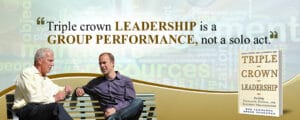
H:
- Hard Edge: Good leaders know when to operate at the hard edge of leadership (steel), depending on the situation and people. (See also Chapter 4 of our book, Triple Crown Leadership.)
- Head: Good leaders see head qualities—such as knowledge, education, skills, and experiences—as the minimal bar for hiring. They also seek the invaluable heart qualities. (See also Chapter 2 of our book, Triple Crown Leadership.)
- Heart: Good leaders prioritize and develop heart qualities—such as character, moral compass, emotional intelligence, and courage—in themselves and others. (See also Chapter 2 of our book, Triple Crown Leadership.)
- Hierarchy: Good leaders dislike and avoid hierarchy whenever possible, instead focusing on flexibility, dynamism, relationships, and trust, as well as tiger teams, skunkworks, and other unconventional groupings.
- High Performance: Good leaders inspire high performance.
- Hire: Good leaders recruit and hire people with both heart and head qualities. (See also Chapter 2 of our book, Triple Crown Leadership.)
- Honor: Good leaders are honorable.
- Humble: Good leaders are humble.
I:
- Inclusive: Good leaders are inclusive.
- Innovation: Good leaders develop capacity in their organizations to translate ideas or inventions into products or services that create value in the marketplace.
- Inspire: Good leaders inspire their colleagues.
- Integrity: Good leaders have integrity and show it consistently over time, including acknowledging when they make mistakes and taking responsibility for them.
J:
- Judgment: Good leaders have developed sound judgment and rely on it heavily when making decisions.
L:
- Learners: Good leaders are lifelong learners.
- Legacy: Good leaders are intentional about creating a great legacy, not just through the results they’ve achieved, but the culture they’ve built and the quality, character, and competencies of their colleagues.
- License: Good leaders give people an automatic license to lead by the shared values.
- Listen: Good leaders are excellent listeners.
- Loner: Good leaders aren’t loners. They connect with their colleagues.
- Long Game: Good leaders play the long game by doing the right thing and systematically taking the difficult steps to create lasting value, instead of taking shortcuts, borrowing from the future, and operating unsustainably.
- Love: Good leaders radiate love and appreciation rather than fear. They love their people and their work and show it in their actions.
- Loyal: Good leaders are loyal; they have their people’s backs.
M:
- Made: Good leaders are made, not born, by developing their character, mindset, and skills.
- Management: Good leaders are also good managers, skilled at directing people through planning, organizing, and controlling resources.
- Maverick: Good leaders protect the mavericks who subscribe to the shared values and culture of the organization.
- Maximize: Good leaders don’t maximize one stakeholder by sub-optimizing others.
- Meaning: Good leaders help followers find meaning and purpose in their work.
- Mindset: Good leaders have healthy mindsets, including a growth mindset—the belief that we can all develop our intelligence, abilities, and talents over time.
- Mission: Good leaders focus not just on mission—what the organization does and where—but also the purpose, which is the organization’s reason for being, its deeper why.
- Mistakes: Good leaders learn from their mistakes and encourage others to do so too.
- Moral Compass: Good leaders have a strong moral compass that guides their decisions and actions.
- Motivate: Good leaders motivate themselves and others to do great things together.
- Mutterers: Good leaders don’t tolerate mutterers (the ones who sit quietly in the meeting, nodding their heads and going along, and then mutter complaints, insults, and frustrations under their breath after the meeting).
N:
- No: Good leaders know when to say “no” to stay focused on what’s essential.
O:
- Objectors: Good leaders recognize that organizations and teams need people who have the courage to speak up, object to things that are problematic, and ask tough questions.
- Onboarding: Good leaders encourage culture orientation as part of a thoughtful, comprehensive onboarding process.
- Optimistic: Good leaders are optimistic about the future while remaining grounded in reality.
- Others: Good leaders are focused on others, not themselves.
P:
- Paradigm: Good leaders take others to a new paradigm, a new state, place, or perspective that’s better than where the group was before.
- Passion: Good leaders demonstrate passion and tap into the passions of their team.
- Performance Reviews: Good leaders give frequent, constructive feedback instead of waiting for an occasional performance review.
- Persist: Good leaders persist in worthy endeavors but also know when to let go.
- Personal Development: Good leaders systematically develop their colleagues with education, training, coaching, mentoring, stretch assignments, feedback, and more.
- Personal Values: Good leaders have defined their sacrosanct personal values and live by them.
- Persuade: Good leaders persuade more often than they dictate.
- Plan B: Good leaders develop a Plan B in case things don’t go as expected.
- Potential: Good leaders understand that people have inherent potential that can be unleashed.
- Power: Good leaders seldom use their position power, focusing instead on collaboration and persuasion.
- Profit: Good leaders see profit as a result of being excellent, ethical, and enduring, not an end in itself.
- Promise: Good leaders keep their promises.
- Promote: Good leaders promote people who have both head and heart, who get results ethically, honor the shared values, and contribute to the organization’s culture.
- Protect: Good leaders protect the “colors” (shared purpose, values, and vision), culture, and mavericks in an organization.
- Psychological Safety: Good leaders establish psychological safety in their organizations—a shared sense that the team has a safe place for learning, contributing, risk-taking, and challenging the status quo.
- Public Speaking: Good leaders develop their public speaking ability to communicate effectively.
- Purpose: Good leaders help develop and then advocate their organization’s core purpose, its fundamental reason for being.
Q:
- Quality: Good leaders have a healthy focus on quality—quality people, systems, processes, and results.
- Quest: Good leadership is a lifelong quest. (See also Chapter 1 of our book, Triple Crown Leadership.)
- Questions: Good leaders ask questions frequently, letting people uncover what they inherently know. And they also use questioning to drive innovation.
R:
- Reality: Good leaders acknowledge reality.
- Recognition: Good leaders recognize their colleagues publicly, generously, and often.
- Relationships: Good leaders build relationships, investing time in people.
- Renewal: Good leaders practice renewal regularly to ensure they’re rested, fresh, and clear-headed for the challenges ahead.
- Respect: Good leaders show others respect and earn respect from others.
- Responsible: Good leaders accept full responsibility.
- Results: Good leaders get results ethically. (See also Chapter 1 of our book, Triple Crown Leadership.)
- Reward: Good leaders reward their colleagues in generous, creative, and meaningful ways.
- Risk: Good leaders take reasonable risks and mitigate those risks.
- Rules: Good leaders comply with rules but also sense when it’s necessary to break them.
S:
- Sanctuary: Good leaders find sanctuary, places and practices of peace and re-centering for renewal.
- Self-Awareness: Good leaders are self-aware.
- Self-Care: Good leaders practice self-care, recognizing that it’s an investment in themselves so they can preserve the capacity to continue leading at their best over time.
- Self-Control: Good leaders demonstrate self-control.
- Self-Leadership: Good leaders lead themselves well first.
- Self-Righteous: Good leaders are not self-righteous. They’re humble and open to input.
- Servant Leadership: Good leaders serve others, putting the needs of others first, helping people develop and perform, sharing power, and building a sense of community and shared purpose.
- Short Game: Good leaders refuse to take shortcuts, borrow from the future, or operate unsustainably; instead, they play the long game by doing the right thing and taking the difficult steps to create lasting value.
- Short-Termism: Good leaders don’t fall victim to short-termism (the focus on immediate results with disregard for the longer-term implications).
- Silence: Good leaders are comfortable with silence, letting insights and wisdom emerge as people reflect.
- Simplify: Good leaders simplify, distilling things to their essence.
- Skunkworks: Good leaders use skunkworks (small, independent groups, highly empowered to achieve monumental goals) to drive innovation and speed or to help an organization come back stronger from a crisis.
- Small Groups: Good leaders know there’s immense power in small groups that meet periodically to support each other at the deepest levels in a safe place of confidentiality, trust, and respect.
- Smart Trust: Good leaders extend what Stephen M. R. Covey calls “smart trust” (combining propensity to trust with the analysis to manage risky wisely by observing behavior).
- Soft Edge: Good leaders know when to operate on the soft edge of leadership (velvet)—listening, asking, and empathizing—depending on the situation and people. (See also Chapter 4 of our book, Triple Crown Leadership.)
- Soft Skills: Good leaders develop, excel at, and recruit for soft skills (people-related abilities such as emotional intelligence, collaboration, openness, and adaptability).
- Solo: Good leadership is a group performance, not a solo act.
- Soul: Good leaders bring their souls to work and create organizations that have heart and soul.
- Spirit / Spirituality: Good leaders tap into the spirit of people, including love, heart, care, compassion, and service.
- Stakeholders: Good leaders serve all their stakeholders, not just shareholders.
- Steel: Good leaders use steel—the hard edge of leadership (such as accountability, discipline, and execution)—when clearly necessary, depending on the situation and people. (See also Chapter 4 of our book, Triple Crown Leadership.)
- Stewards: Good leaders empower organizational stewards—guardians of the organization’s shared values and culture. (See also Chapter 5 of our book, Triple Crown Leadership.)
- Storytellers: Good leaders are good storytellers.
- Strategy: Good leaders help develop winning strategies (major initiatives for deploying resources to achieve the organization’s goals).
- Sustainable: Good leaders act sustainably so that resources are maintained without being degraded or used up.
- Synthesize: Good leaders synthesize, simplifying complexity in a new way.
T:
- Team: Good leaders are good team members and facilitate excellent teamwork.
- Tiger Teams: Good leaders form empowered tiger teams (or skunkworks), special groups charged with accomplishing a specific goal and that are the disbanded once the work is done.
- Tilt: Good leaders must sometimes tilt toward one of their stakeholders or goals.
- Toxic: Good leaders remove toxic people from the organization.
- Transactional: Good leaders are not only transactional, just giving something in return for receiving something.
- Transformational: Good leaders are more transformational (changing the fundamental nature of something or someone) than transactional.
- Triple Crown Leadership: Good leaders focus on building an excellent, ethical, and enduring organization. (See also Chapter 1 of our book, Triple Crown Leadership.)
- True North: Good leaders are guided by their “true north,” an internal guiding compass.
- Trust: Good leaders give and receive what Stephen M. R. Covey calls “smart trust” (combining propensity to trust with the analysis to manage risky wisely by observing behavior).
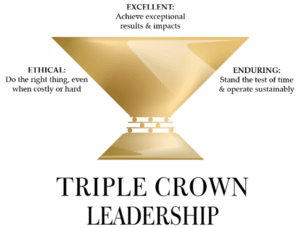
U:
- Unleash: Good leaders unleash other leaders. (See also Chapter 5 of our book, Triple Crown Leadership.)
- Urgency: Good leaders establish a sense of urgency for the organization’s purpose and values, and they establish the need for continuous improvement.
V:
- Values: Good leaders prioritize shared values—an organization’s convictions about what’s most important, and what behaviors to believe in and stand for.
- Values-Based Leadership: Good leaders are champions of values-based leadership—guiding and inspiring workers through the shared values.
- Velvet: Good leaders use velvet—the soft edge of leadership—often, to listen, ask questions, guide, coach, and let others lead. (See also Chapter 4 of our book, Triple Crown Leadership.)
- Ventilation: Good leaders defuse team frustrations by letting people express their concerns, documenting the issues raised so people know they’ve been heard, and helping plan ways to resolve the issues. (See also Chapter 8 of our book, Triple Crown Leadership.)
- Vision: Good leaders help synthesize an emotionally inspiring vision, a compelling picture of what success looks like.
- Voice of One: Good leaders are unafraid to be a voice of one, speaking up on tough issues, even alone.
- Vulnerable: Good leaders reveal their vulnerability.
W:
- Walk: Good leaders “walk their talk” by being what they profess.
- Wander: Good leaders “manage by wandering around,” connecting with people and getting to know the organization better.
- We: Good leaders use “we” much more than “I.”
- Why: Good leaders have a clear understanding of why they lead, including a focus on serving others, not their own egos.
- Wisdom: Good leaders are wise.
- Work Ethic: Good leaders have a strong work ethic.
- Work in Process: Good leaders know they’re a work in process and keep developing themselves without pretending to be perfect or resting on their laurels.
X:
- X-Factor: Good leaders strive to develop an X-factor, a special talent or quality such as extraordinary insight or an ability to simplify complexity.
Y:
- Yes: Good leaders say “yes” more often than “no” when receiving reasonable requests from others.
Z:
- Zealous: Good leaders are zealous about the organization’s shared purpose, values, and vision.
There you have it, an A-Z guide of good leadership practices. Clearly, leadership is challenging and multi-faceted!
What are we missing? Can you add any other words or practices to this guide? Send us a note with your thoughts.
Wishing you well with your leadership quest!
–Gregg and Bob Vanourek

+++++++++++++++++++++++
Gregg Vanourek and Bob Vanourek are leadership practitioners, teachers, and award-winning authors (and son and father). They are co-authors of Triple Crown Leadership: Building Excellent, Ethical, and Enduring Organizations, a winner of the International Book Awards. Check out their Leadership Derailers Assessment or get their monthly newsletter. If you found value in this, please forward it to a friend. Every little bit helps!






